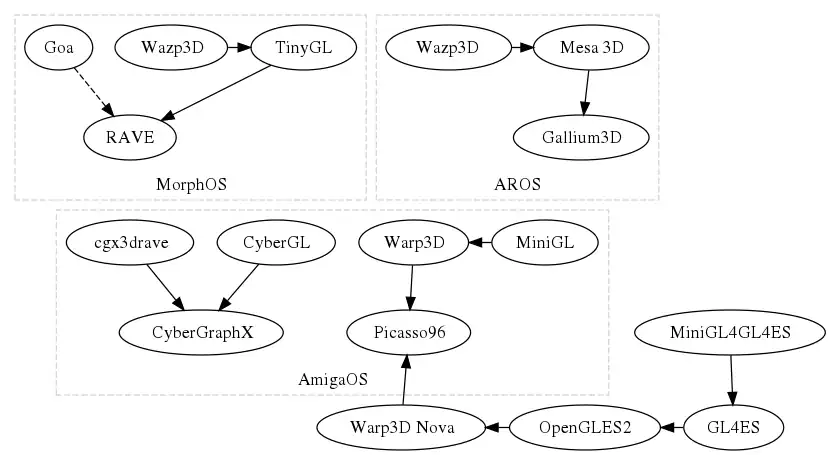Warp3D
Warp3D was a project, founded by Haage & Partner in 1998, that aimed to provide a standard API which would enable programmers to access, and therefore use, 3D hardware on the Amiga.[1][2]
| Developer(s) | Sam Jordan, Hans-Joerg Frieden, Thomas Frieden, Hans De Ruiter |
|---|---|
| Stable release | 53.22
/ May 22, 2013 |
| Operating system | AmigaOS |
| Type | API |
| License | Closed source |
| Website | http://download.haage-partner.de/Amiga/3DWorld/ |
| Developer(s) | Hans De Ruiter for A-EON Technology |
|---|---|
| Stable release | 1.5
/ June 30, 2019 |
| Operating system | AmigaOS |
| Type | API |
| License | Closed source |
| Website | http://wiki.amiga.org/warp3dnova |
Its design was similar to that of both the Picasso96 graphics card drivers and operated in a similar fashion to the 3dfx Glide API, which provided a uniform and standardised way for programmers to create software for the 3D graphics cards that were available at the time.[1]
It was hoped that the creation of this API would not only encourage the development and release of more 3D graphics cards, but also move away from the situation where a new piece of hardware had been developed with no software available to run on it. If the particular piece of software used the Warp3D API (enabled through a shared library), any current or newly developed hardware would be able to be used.[1][3] Hyperion Entertainment developers created OpenGL subset called MiniGL sitting on top of Warp3D to ease porting of games such as Heretic II.[4]
At time of its release, Warp3D provided significant speed increase over software rendering.[5] Years later however, newer 3D APIs (e.g. TinyGL in MorphOS) offered better performance on the same hardware.[6]
In 2014, it was announced that Warp3D was now jointly owned by British company A-EON Technology Ltd.[7] On April 1, 2015, A-EON Technology subsequently released Warp3D for RadeonHD (Southern Islands chipset).[8]
In March 2016, A-EON Technology Ltd announced that they had developed the new Warp3D Nova featuring support for Shaders.[9][10] Warp3D Nova was originally mentioned as planned complete rewrite and Shader-centric design in the AmigaOS 4.0 Feature List more than decade earlier.[11][12] Development of the new release intentionally took some inspiration from this original Warp3D Nova plan.[13] The pre-release version 1.15 was published on 1 May 2016 in the Enhancer Software package for AmigaOS 4.[14][15] Apart from its name and being related to 3D graphics, Warp3D Nova has nothing in common with the original Warp3D.
Also in March 2016 A-EON Technology Ltd announced that Daniel Müßener / GoldenCode.eu had been hired to create an OpenGL ES 2 implementation on top of Warp3D Nova.[9] The first public version 1.4 was released on 31 August 2016 as part of the Enhancer Software package version 1.1.[16]
Running Requirements
Warp3D requires the following in order to work properly
- An AmigaOS compatible system with CyberGraphX or Picasso96, containing:
- At least a 68040 processor with FPU for AmigaOS versions predating 4.0
- A PowerPC CPU for AmigaOS 4.0+
- Optionally PowerPC supported on WarpOS[1]
- Any of these graphics cards:
- CyberVision 3D
- CyberVision PPC
- BlizzardVision PPC[17]
- Any 3Dfx Voodoo card
- ATI Radeon R100, R200
- ATI RadeonHD Southern Islands graphics cards
It also requires 3D hardware to be present, and will not run with graphics cards that are 2D only, or AGA, ECS or OCS.[18]
Other implementations

Alain Thellier created open source clone called Wazp3D.[19] MorphOS included a Warp3D implementation known as Goa3D Graphics Library developed by Nicolas Sallin.[20]
References
- "What is Warp3D". 2006. Retrieved 23 June 2016.
- Vost, Ben (March 1999). "What's on your disc? At your fingertips, Go 3D". Amiga Format. No. 121. Future Publishing. p. 98. ISSN 0957-4867.
- Šostý, Lumír (July 1999). "Warp3D". Amiga Review (in Czech). No. 46/47. Atlantida Publishing. p. 44. ISSN 1211-1465.
- Vost, Ben (December 1999). "Previews, Heretic II". Amiga Format. No. 130. Future Publishing. pp. 28–29. ISSN 0957-4867.
- Šostý, Lumír (July 1999). "Warp 3D: ADescent - tentokráte srovnání verzí". Amiga Review (in Czech). No. 46/47. Atlantida Publishing. p. 45. ISSN 1211-1465.
- Brunet, David (September 2009). "Comparatif : Performances entre AmigaOS 4.1 et MorphOS 2.3 sur Pegasos II". obligement.free.fr (in French). Retrieved September 25, 2016.
- "A-EON Software Update" (PDF) (Press release). AmiWest 2014 (Sacramento): A-Eon Technology. October 25, 2014. Retrieved June 23, 2016.
{{cite press release}}: CS1 maint: location (link) - "New 3D drivers for AmigaOS 4.1" (PDF) (Press release). Cardiff: A-Eon Technology. April 1, 2015. Retrieved June 23, 2016.
- "Introducing Warp3D Nova" (PDF) (Press release). Cardiff: A-EON Technology Ltd. March 22, 2016. Retrieved March 22, 2016.
- Förster, Moritz (2016-03-24). "Alternative Betriebssysteme: Neues 3D-Treibersystem für AmigaOS 4". iX magazine (in German). Retrieved 2016-10-29.
- "AmigaOS 4.0 Feature List Revision 1.0" (PDF). intuitionbase.com. Hyperion Entertainment. January 7, 2003. pp. 11–12. Retrieved September 25, 2016.
- Williams, Robert (Spring 2003). "AmigaOS 4 Update" (PDF). Total Amiga. No. 14. South Essex Amiga Link. p. 15.
- "Introducing Warp3D Nova for OS4". Amigaworld.net. March 23, 2016. Post 59 by Hans. Retrieved September 25, 2016.
- "Enhancer Software Released On AMIStore (OS4)" (Press release). Cardiff: A-EON Technology. AmigaWorld.net. May 1, 2016. Retrieved September 24, 2016.
- "Changelog". amiga.org. May 1, 2017. Amiga Kit. Retrieved August 16, 2017.
- "Enhancer Software v1.1 Released - Amiga.org". www.amiga.org. Retrieved 2017-11-15.
- "Warp3D 3.0 Read Me". 27 March 2007. Retrieved 12 June 2010.
- "Warp3D 4.2a Read Me". 13 October 2002. Retrieved 23 June 2016.
- "Wazp3D". Retrieved 17 July 2010.
- "Goa3D Graphics Library". Retrieved 17 July 2010.
Further reading
- "Active Gamer - Warp3D 4.2 for Voodoo3". Amiga Active. No. 24. Pinprint Publishing. September 2001. pp. 50–. ISSN 1467-3533.
- "Warp Factor 3D!". Amiga Active. No. 25. Pinprint Publishing. October 2001. pp. 46–. ISSN 1467-3533.
- "Warp3D Masterclass". Amiga Active. No. 26. Pinprint Publishing. November 2001. pp. 48–. ISSN 1467-3533.